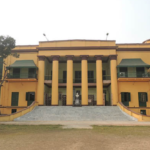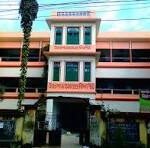Uttarpara Jaykrishna Public Library, recognized as the first free public library in India, stands as a monumental institution in the annals of Indian educational and cultural history. Founded by the illustrious zamindar Jaykrishna Mukherjee, the library has been a beacon of knowledge and enlightenment since its inception in 1859. Influenced by Dwarkanath Tagore and guided by the London Public Library Act of 1850, Jaykrishna Mukherjee initiated this novel venture at a time when modern public education was still a distant dream in Bengal and India.
Foundation and Early Years
The construction of the library building commenced in 1856 on a sprawling one-acre plot at a cost of Rs. 85,000. The two-storied library, complete with an outhouse and flower garden, officially opened its doors on April 15, 1859. However, it had already started serving scholars and researchers as early as 1851. The library’s inception marked a significant milestone in the cultural and educational landscape of India.
A Hub of Intellectual Activity
The Uttarpara Jaykrishna Public Library is renowned for its association with many illustrious personalities. Michael Madhusudan Dutta, the great Bengali poet, spent the last few months of his life in the library building. Rishi Aurobindo delivered his famous ‘Uttarpara Speech’ here, revealing his spiritual realizations to the public for the first time on May 30, 1909. The library has also been frequented by luminaries such as Governor Sir Ashley Eden, Miss Mary Carpenter, Sir Edwin Arnold, Sir River Thomson, Marquis of Dufferin and Ava, Iswar Chandra Vidyasagar, Surendra Nath Banerjee, Bipin Chandra Pal, and Keshab Chandra Sen.
The Collection: A Treasure Trove
Sir William Hunter, who resided in the library for three years while compiling his statistical accounts of Bengal and the Imperial Gazetteer, described it as a “Treasure House.” The library boasts an immensely rich collection of primary printed materials essential for studies of the 17th to 19th centuries, comprising about 50,000 to 60,000 books. This collection includes rare and old periodicals in both Bengali and English, such as the Dig Darson (1818), Bengal Chronicle (1821), and Calcutta Monthly Journal (1798).
In 1952, Dr. S. R. Ranganathan, the National Professor of Library Science, visited the library and remarked that a major portion of its collection could not be found even in the largest libraries in the country. The library’s collection also features 2,500 old periodicals, 65,000 new Bengali and English books, 20,000 bound new periodicals, and 450 manuscripts.
The Majestic Library Building
Overlooking the serene Hooghly River, the library’s majestic building has been a silent witness to numerous historical events. The building itself is a testament to the architectural grandeur of the era and continues to be a significant landmark in Uttarpara.
Modern Developments and Services
The library has continued to evolve and expand its services over the years. In 1998, an annexed building was acquired, and in 2003, a Braille section was established, catering to visually impaired readers. The library is organized into various sections, including Reading, Lending, Newspaper (Daily), Children’s, Newspapers & Periodicals (Old), Career Guidance, Research, and Reference.
The library sees a substantial daily footfall, with 74-89 users for lending, 100-120 for reading, 30-35 children, 5-6 researchers, 30-35 for reference, 50-60 for newspapers, and 40-45 for career guidance. The staff strength is currently 18, with 7 technical and 11 non-technical members.
Notable Visits and Recognitions
The library has hosted numerous eminent personalities over the years. The famous catalogue by Rev. James Long, published in 1855, was primarily based on the collection of this library. Additionally, the library’s significance was further highlighted during the visits of notable figures such as Governor Sir Ashley Eden, Miss Mary Carpenter, Sir Edwin Arnold, and many others.
Continuing the Legacy
As a government district library since 1964 and designated as a Group “A” Library by the Government of West Bengal in 2001, Uttarpara Jaykrishna Public Library continues to uphold its mission of promoting knowledge and education. The library remains a cornerstone of Uttarpara’s cultural and intellectual heritage, inspiring future generations to pursue knowledge and wisdom.
Conclusion
Uttarpara Jaykrishna Public Library is more than just a repository of books; it is a living testament to the vision and dedication of Jaykrishna Mukherjee and the cultural renaissance of Bengal. As it continues to evolve and adapt to modern needs, the library remains a cherished institution, preserving the rich legacy of the past while nurturing the intellectual growth of the present and future.




